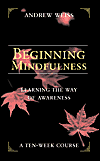
One of the members of my meditation community in Maynard, Massachusetts, introduced me to Tonglin and it rapidly became one of my favorite practices. I prefer practices that put me at the edge of the cliff and don't give me room to wriggle out. My mind is so good at avoiding that I appreciate and benefit most from practices that hold my feet to the fire. Tonglin is one of those practices.
Tonglin practice is rooted in the breath. If you can breathe in and out, you can practice tonglin. Tonglin works with a sense of breathing that may be foreign to you at first, because it sees the in-breath as drawing in and the out-breath as opening up. You may tend to see the in-breath as expansive, because your lungs expand and because you have a natural feeling of spaciousness, and you may see the out-breath as contracting because your lungs contract.
To get the experience of how tonglin works with the breath, try this: Take an in-breath with awareness that you are bringing all of the energy from outside yourself and inside yourself into one concentrated point in your lungs. Then, let your out-breath happen with awareness that you are allowing all of that energy to flow expansively outward, through all the cells in your body and out into the world around you. Once you have tried this a few times, you may find, as I have, that it becomes a natural way to experience breathing.
Tonglin Is Very Direct
The essence of the practice is to breathe in the suffering of another person and to breathe out loving-kindness, compassion, and healing. All of us have reference points for pain, and for joy and healing, in our lives; we can practice breathing in suffering and breathing out healing because we know that both exist.
When I describe it this way, many of my students' first reaction is, "Won't someone else's suffering contaminate me? Shouldn't I be breathing my own suffering out? What if the suffering I breathe in overwhelms me? What if I don't have any healing energy to offer?"
In fact, tonglin is balanced: We do not drown in suffering because tonglin constantly reminds us to breathe out healing; we do not hide in false joy because tonglin constantly reminds us to breathe in suffering. We receive and we give.
The Practicalities of Tonglin
In tonglin practice, we think of a person we know who is suffering and whom we want to help. Perhaps we visualize that person in front of us. We can see or sense their suffering. And we breathe in. We offer to take that suffering into our own being, trusting that the resources for healing are inside of us. And we breathe that healing out, making our offering to the other person. We are making the greatest gift we can, the gift of our loving and healing energy, to help relieve another's suffering.
As you breathe in suffering and breathe out healing, you will find quite naturally that compassion arises. This is because a compassionate response to suffering is to offer some help. In tonglin, awareness of suffering and compassionate action are inextricably linked together.
Our Suffering Is Not Separate
The questions my students raise come from their fears, and you may find that you share them. Tonglin taps into the reality that when we focus on the suffering of another person, our own suffering also surfaces. Frequently, the suffering we encounter in ourselves is the same as that of the person we are offering to help.
For example, my first wife died in 1982, and when I offer to breathe in the suffering of someone who has lost a spouse or other family member, what I first encounter are my own feelings about Sara's death. Tonglin helps me to realize that what causes others to suffer is the same as what causes me to suffer. And once I touch the tenderness and beauty, and the grief and helplessness, I feel from Sara's death, those feelings extend to the other person who has suffered a loss and for whom I'm doing the tonglin.
At other times, the suffering we encounter is not so directly related. I have encountered powerlessness, hopelessness, feeling overwhelmed, and at times just being stuck. When these feelings are present, the suffering I encounter may seem more than I can handle.
We always start where we are, so at those times I have begun by offering healing to myself for the piece of suffering that is right in my face. But as I breathe in this suffering, I also allow myself to breathe in all of the powerlessness, hopelessness, or overwhelmed stuckness of everyone else. That is the spirit of tonglin, recognizing that we are not separate, that our suffering is not separate. If we are to benefit, it is because everyone benefits, and vice versa.
We Are Not Alone
It's more important that I locate the feelings in my body than label them, so I dive into my churning stomach or aching back and I breathe in everyone's churning stomach or aching back. Then I breathe out the calm, stability, and serenity to heal it. In this direct way, I encourage myself to drop the barrier of separation and isolation.
Occasionally I feel as though I cannot find what will heal the suffering I've encountered. When this happens, I first become aware of my breathing and then of the feelings that are going on. Am I panicked or worried? I breathe in with panic or worry, and with some realization that others in the world are also panicked or worried.
Then I breathe out with compassion for the panic or worry -- not just mine, but others' as well. The most important thing is to be present to the panic, to breathe in with everyone in the world who experiences panic, and to breathe out with compassion and with relief that we are not alone.
Breathing In and Breathing Out
When you want to help someone who is suffering and you begin tonglin, perhaps you will find yourself worried that you'll drown in your friend's suffering. Try to breathe in the worry of everyone in the world and breathe out whatever will heal that worry. Do this for ten or fifteen minutes and see what happens.
We don't do tonglin just for another person or just for ourselves, because tonglin makes real for us the lack of separateness of "self" and "other." Because we are breathing in the suffering of another, our own suffering gets triggered. Because we are breathing out healing for another, we heal ourselves.
Tonglin also taps into something powerful that most spiritual traditions acknowledge: We help to alleviate our own suffering when we help to alleviate the suffering of others. My wife Avril's first meditation teacher, Baba Muktananda, would frequently tell people who came to him and complained of the woes in their lives, "Go and do something good for someone else." Tonglin is a concrete way of offering healing to others and healing ourselves at the same time.
As I practice tonglin, the barriers dissolve and the weight of suffering becomes much less. At first, what I experience is that I am no longer suffering in isolation; we are all in it together. Then, as I continue to breathe in the suffering or pain, all ownership of that suffering or pain begins to dissipate. It's not my suffering, and it isn't the other person's suffering either. It's just suffering, part of the condition of human consciousness.
Tonglin is described as the practice of "exchanging self and other." This isn't simply putting ourselves in another person's situation. It's acknowledging, and experiencing as a living reality, the existence of suffering and the existence of healing, compassion, and loving-kindness in human consciousness. The suffering and healing don't belong to me, and they don't belong to you; they belong to all of us.
When I practice tonglin for someone who is dying or someone who is mourning the death of a loved one and my recollection of Sara's death comes up, the experience of having someone die and the feelings that go with it become something universal. There is endless death, endless sadness, endless love and compassion -- not mine, not his or hers. The experience is ours, it's part of all of us, it comes up when the conditions are right for it to come up, and it goes away when the conditions are right for it to leave. And that, ultimately, is the reality of this thing we call our "self": a succession of thoughts, feelings, and perceptions that we all somehow share in common.
Ongoing Tonglin Practice
While tonglin is traditionally done as a sitting meditation practice, I have found that I use it frequently during the day. When I am at work and see people with a lot of hurt, anger, or difficulty, I will take a moment or two to practice tonglin for them and for myself.
I find tonglin a versatile practice. Tonglin traditionally has four stages. When I use the practice myself, I divide up one of those stages, making six, and I suggest trying this way of guiding yourself:
1. Become aware of your breathing and allow yourself and your breath to come to a place of rest. Bring your breath into your body, and become aware of the spaciousness each in-breath opens in your body, and of the movement of breath and energy each out-breath creates.
2. Become aware of breathing as a process of exchange. Allow yourself on every in-breath to be aware of air coming from a huge ocean of air that surrounds you, down the river of your nose and breathing tubes into the lake of your lungs and abdomen. Allow yourself on every out-breath to sense the air going from the lake in your lungs and abdomen back up the river and out into the ocean of air surrounding you.
3. Become aware of the nature of exchange: It is always reciprocal and mutually sustaining. I use a plant as a focus point for this. The air I breathe in contains oxygen, which the plant produces and which I need to live. The air I breathe out contains carbon dioxide, which my body produces and which the plant needs to live.
4. Allow your awareness of your breathing to move into your heart-space. This is the area in the center of your chest at the same level where your heart is. Notice any sadness, pain, or difficulty that you are experiencing. Breathe in your sadness, pain, or difficulty, and as you breathe out, offer love and compassion, to yourself from your heart.
5. Now begin working with the person and situation to which you want to offer healing. Step out of your heart-space and return to awareness of your breath coming in through your nose, going down the river of your breathing apparatus to the lake of your belly, and then back up the river to the ocean of air surrounding you. Breathe in the other's suffering and breathe out loving-kindness, compassion, and healing. Don't hold the suffering inside. Let the natural process of breathing -- the passage of air from your nose to your belly and back again, looping through your heart-space -- transform the suffering into love and compassion, and move it out. If your own problems stand in your way, then work first with whatever comes up for you; breathe in that feeling, thought, or sensation not only for yourself but also for all people who feel the same thing. Do your best to maintain awareness of how your suffering and the other person's or people's suffering intersect.
6. Expand your scope. Instead of breathing in the suffering of one friend, breathe in the suffering of all people in the same situation. If your friend has AIDS, breathe in the suffering of everyone who has AIDS. If your friend is going through a divorce, breathe in the suffering of everyone who has endured the wrenching coming-apart of an intimate relationship. If you are working with anxiety, see what happens if you breathe in to heal the anxiety of someone who has made you suffer. If you can do tonglin for them too, you'll see that they have the same anxiety inside themselves that you do. Maintain your awareness of your own feelings that come up when you do this.
Expanding Our Awareness of Suffering
Tonglin practice is not about escape. It is also not about pretense. We only do what we can. Each session offers us the opportunity to expand our awareness of suffering in the world and to offer something positive to help. Each session helps us melt a little more the illusion that we are separate.
Tonglin embodies Muktananda's teaching: In offering to help another, we help ourselves. In the face of great pain and suffering, we have something to offer. We can "exchange self and other" (as the teacher Lama Surya Das puts it) and even if only momentarily, tap into the great well of healing and suffering that arises and passes away in the vastness of human consciousness.
In a very practical way, I find that tonglin is a perfect practice for the times when I am listening to someone in a tough position in his or her life. It helps me to bear witness to that suffering. As I listen, I breathe in the pain and anguish; as I breathe out, I offer compassion and healing. I find this helps me to stay present with the other person and to listen more attentively.
Disconnecting and Letting Go
When I started doing my version of tonglin practice, I found that I would frequently carry the subject of my practice around with me afterward. The symptom: thoughts about him or her would come up unbidden, or I would have feelings that had nothing to do with my life or experiences.
It's not healthy for us to stay connected to someone in that way because we can get confused about whose thoughts or feelings we are experiencing. This can lead us to act in unconscious ways. To prevent this from happening, I make it a point to "disconnect" after practice: I say good-bye consciously, and I do it as many times as is necessary. I encourage you to do the same.
Tonglin is a practice from the Tibetan tradition. Of the teachers writing on tonglin, I particularly suggest reading the works of Pema Chodron.
Cultivating the Heart of Compassion
The more you do tonglin and metta, the more your relationships with everyone (and everything) around you will change. Metta [meditation focused on the development of unconditional love for all beings] cultivates the heart of loving-kindness, and tonglin cultivates the heart of compassion. They take us through our own world and show us how much our world and the world of others are interlaced. In fact, those worlds are inseparable. Our situations may be different, and the precise manifestation of our suffering may be different, but our feelings, desires, thoughts, and aspirations are the same.
Metta and tonglin focus our attention on real people and real situations, and they encourage us to bear witness to the pain and joy in the life of the world. They encourage us to practice non-separation, to develop our understanding that the well-being of everyone and everything in the universe is part of our own well-being.
Compassion and loving-kindness both spring from and nourish this understanding. Once this understanding stops being a concept in our mind and becomes a living reality, our lives change. In my experience, longtime practitioners of metta and tonglin soften around the edges, and those who encounter them feel seen, heard, and deeply recognized.
These two wonderful practices help us expand the horizon of our awareness. Ultimately they lead us to the experience that Zen Master Seung Sahn calls "not one and not two." We are, each of us, an individual manifestation of something that is not individual at all. Our thoughts, feelings, perceptions, and sensations endlessly arise and fall away, they belong to us and they don't belong to us, and at any given moment you and I, this book, the chair you're sitting on, and the weather outside are perfect and necessary expressions of the cosmos.
Tonglin reminds us that, if we want to experience the ultimate reality, we have to experience it in the here and now of our physical reality. If we want to find the ecstasy, we'll find it in the laundry!
HOME PLAY
FORMAL PRACTICE: Find another person with whom you have a hard time; see if you can locate the suffering that causes him or her to act the way he or she does toward you, and see if you can offer tonglin healing for his or her suffering. See how your relationship with that person changes over the week. See whether you can extend tonglin to a difficult situation in the world (such as an area where there is much tension and conflict); see what feelings this brings up for you and how tonglin works with that.
INFORMAL PRACTICE: Take tonglin breaks during the day. Incorporate the intention of tonglin into your mindful speech and deep listening. See what difference it makes to you and to the other person if you listen with attentiveness and with the intention to offer healing to that person just through your listening presence. Try speaking with honesty and with the awareness of how your words can help to create true healing in the situation you are in.
©2004. Reprinted with permission of the publisher
New World Library. http://www.newworldlibrary.com
Article Source:
 Beginning Mindfulness: Learning the Way of Awareness
Beginning Mindfulness: Learning the Way of Awareness
by Andrew Weiss.
Knowing that most people do not stop their lives to engage in spiritual practice, Buddhist teacher Andrew Weiss has always taught the direct application of practice to daily life. While also teaching sitting and walking meditation, he emphasizes mindfulness — the practice of seeing every action as an opportunity to awaken meditative inquiry. Over the years, Andrew has honed his teachings into an effective ten-week course with progressive steps and home-play assignments. Beginning Mindfulness is intended for anyone practicing in daily life without the luxury of long meditation retreats. Weiss skillfully blends the traditions of his teachers into an easy and humorous program of learning the Buddhist art of mindfulness.
Info/Order this paperback book and/or download the Kindle edition.
About the Author

Meditation teacher Andrew JiYu Weiss is ordained in both Thich Nhat Hanh's Order of Interbeing and the White Plum Lineage of the Japanese Soto Zen tradition. Andrew is founder of the Clock Tower Sangha in Maynard, Massachusetts. Visit his website at www.beginningmindfulness.com.
Related Books
at InnerSelf Market and Amazon

























